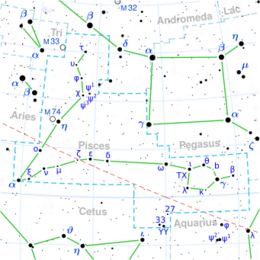Astronomy:Psi1 Piscium
| Observation data {{#ifeq:J2000|J2000.0 (ICRS)|Epoch J2000.0 Equinox J2000.0 (ICRS)| [[History:Epoch|Epoch J2000]] [[Astronomy:Equinox (celestial coordinates)|Equinox J2000}} | |
|---|---|
| Constellation | Pisecs |
| ψ1 Psc A | |
| Right ascension | 01h 05m 40.95527s[1] |
| Declination | +21° 28′ 23.4489″[1] |
| Apparent magnitude (V) | 5.273[2] |
| ψ1 Psc B | |
| Right ascension | 01h 05m 41.71111s[3] |
| Declination | +21° 27′ 55.6120″[3] |
| Apparent magnitude (V) | 5.455[2] |
| Characteristics | |
| ψ1 Psc A | |
| Spectral type | A1V + A4V[4] |
| U−B color index | −0.12[5] |
| B−V color index | −0.04[5] |
| ψ1 Psc B | |
| Spectral type | A0Vn[6] |
| U−B color index | −0.17[5] |
| B−V color index | −0.06[5] |
| Astrometry | |
| ψ1 Psc A | |
| Radial velocity (Rv) | −3.90±2.9[7] km/s |
| Proper motion (μ) | RA: 44.49[1] mas/yr Dec.: −14.82[1] mas/yr |
| Parallax (π) | 11.86 ± 0.68[1] mas |
| Distance | 280 ± 20 ly (84 ± 5 pc) |
| Absolute magnitude (MV) | +0.71[8] |
| ψ1 Psc B | |
| Radial velocity (Rv) | −7.20±3.6[9] km/s |
| Proper motion (μ) | RA: 54.952[3] mas/yr Dec.: −15.938[3] mas/yr |
| Parallax (π) | 11.3778 ± 0.0506[3] mas |
| Distance | 287 ± 1 ly (87.9 ± 0.4 pc) |
| Absolute magnitude (MV) | +0.89[8] |
| Orbit[4] | |
| Primary | ψ1 Psc Aa |
| Companion | ψ1 Psc Ab |
| Period (P) | 14.44±0.26 yr |
| Semi-major axis (a) | 114.3±1.7″ |
| Eccentricity (e) | 0.519±0.027 |
| Inclination (i) | 77.43±0.81° |
| Longitude of the node (Ω) | 134.8±1.2° |
| Periastron epoch (T) | B 2007.512±0.041 |
| Argument of periastron (ω) (secondary) | 305.4±2.3° |
| Details | |
| ψ1 Psc Aa | |
| Mass | 2.2[10] M☉ |
| ψ1 Psc Ab | |
| Mass | 1.7[10] M☉ |
| Details | |
| ψ1 Psc B | |
| Mass | 2.6[3] M☉ |
| Radius | 2.2[3] R☉ |
| Luminosity | 57[3] L☉ |
| Surface gravity (log g) | 4.04[3] cgs |
| Temperature | 10,694[3] K |
| Rotational velocity (v sin i) | 250[11] km/s |
| Age | 210[3] Myr |
| Other designations | |
| ψ1 Psc A: {{{names1}}} | |
| ψ1 Psc B: {{{names2}}} | |
| Database references | |
| SIMBAD | ψ1 Psc A |
| ψ1 Psc B | |
Psi1 Piscium (Psi1 Psc, ψ1 Piscium, ψ1 Psc) is a binary star in the constellation Pisces. It is approximately 280 light years from Earth, based on its parallax.[1]
The two components of Psi1 Piscium are both A-type main-sequence stars.[4][6] The primary has an apparent magnitude of 5.273, while the secondary is slightly dimmer, with an apparent magnitude of 5.455.[2] The primary itself is a close binary, with two A-type stars that orbit each other every 14.44 years.[4]
Psi1 Piscium is moving through the Galaxy at a speed of 22.5 km/s relative to the Sun. Its projected Galactic orbit carries it between 22,800 and 24,300 light years from the center of the Galaxy.[12]
Naming
In Chinese, 奎宿 (Kuí Sù), meaning Legs (asterism), refers to an asterism consisting of refers to an asterism consisting of ψ1 Piscium, η Andromedae, 65 Piscium, ζ Andromedae, ε Andromedae, δ Andromedae, π Andromedae, ν Andromedae, μ Andromedae, β Andromedae, τ Piscium, 91 Piscium, υ Piscium, φ Piscium and χ Piscium. Consequently, the Chinese name for ψ1 Piscium itself is 奎宿十六 (Kuí Sù shíliù, English: the Sixteenth Star of Legs.)[13]
References
- ↑ 1.0 1.1 1.2 1.3 1.4 1.5 van Leeuwen, F. (2007). "Validation of the new Hipparcos reduction". Astronomy and Astrophysics 474 (2): 653–664. doi:10.1051/0004-6361:20078357. Bibcode: 2007A&A...474..653V.
- ↑ 2.0 2.1 2.2 Høg, E. (2000). "The Tycho-2 catalogue of the 2.5 million brightest stars". Astronomy and Astrophysics 355: L27–L30. Bibcode: 2000A&A...355L..27H.
- ↑ 3.00 3.01 3.02 3.03 3.04 3.05 3.06 3.07 3.08 3.09 3.10 Vallenari, A. et al. (2022). "Gaia Data Release 3. Summary of the content and survey properties". Astronomy & Astrophysics. doi:10.1051/0004-6361/202243940 Gaia DR3 record for this source at VizieR.
- ↑ 4.0 4.1 4.2 4.3 Horch, Elliott P.; Gomez, Shamilia C.; Sherry, William H.; Howell, Steve B.; Ciardi, David R.; Anderson, Lisa M.; Van Altena, William F. (2011). "Observations of Binary Stars with the Differential Speckle Survey Instrument. Ii.hipparcosstars Observed in 2010 January and June". The Astronomical Journal 141 (2): 45. doi:10.1088/0004-6256/141/2/45. Bibcode: 2011AJ....141...45H. https://authors.library.caltech.edu/22553/.
- ↑ 5.0 5.1 5.2 5.3 Tolbert, C. R. (1964). "A UBV Study of 94 Wide Visual Binaries". Astrophysical Journal 139: 1105. doi:10.1086/147852. Bibcode: 1964ApJ...139.1105T.
- ↑ 6.0 6.1 "* 74 Psc B". SIMBAD. Centre de données astronomiques de Strasbourg. http://simbad.u-strasbg.fr/simbad/sim-basic?Ident=%2A+74+Psc+B.
- ↑ Gontcharov, G. A. (2006). "Pulkovo Compilation of Radial Velocities for 35 495 Hipparcos stars in a common system". Astronomy Letters 32 (11): 759–771. doi:10.1134/S1063773706110065. Bibcode: 2006AstL...32..759G.
- ↑ 8.0 8.1 Anderson, E.; Francis, Ch. (2012). "XHIP: An extended hipparcos compilation". Astronomy Letters 38 (5): 331. doi:10.1134/S1063773712050015. Bibcode: 2012AstL...38..331A.
- ↑ Kharchenko, N. V. (2007). "Astrophysical supplements to the ASCC-2.5: Ia. Radial velocities of ~55000 stars and mean radial velocities of 516 Galactic open clusters and associations". Astronomische Nachrichten 328 (9): 889. doi:10.1002/asna.200710776. Bibcode: 2007AN....328..889K.
- ↑ 10.0 10.1 Tokovinin, Andrei (23 February 2018). "The Updated Multiple Star Catalog". The Astrophysical Journal Supplement Series 235 (1): 6. doi:10.3847/1538-4365/aaa1a5. Bibcode: 2018ApJS..235....6T.
- ↑ Howe, K. S.; Clarke, C. J. (January 2009). "An analysis of v sin (i) correlations in early-type binaries". Monthly Notices of the Royal Astronomical Society 392 (1): 448–454. doi:10.1111/j.1365-2966.2008.14073.x. ISSN 0035-8711. Bibcode: 2009MNRAS.392..448H.
- ↑ Psi-1 Piscium A (HIP 5131)
- ↑ (in Chinese) AEEA (Activities of Exhibition and Education in Astronomy) 天文教育資訊網 2006 年 5 月 19 日
 |


